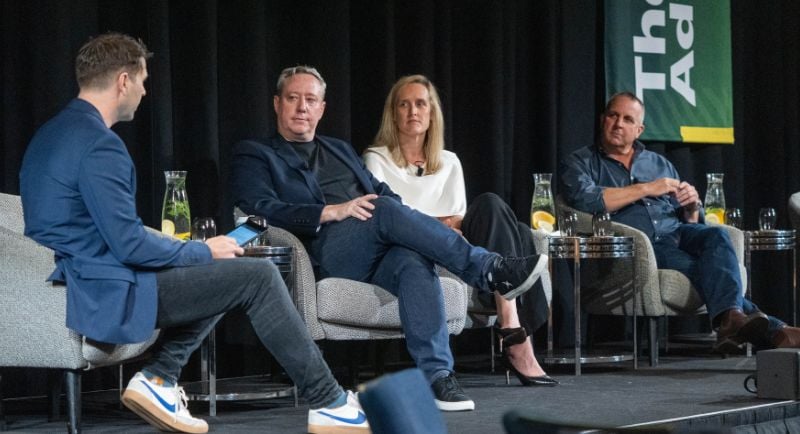Australia’s ad market may be steady for now, but agency leaders are watching global tremors closely. At The Future of TV Advertising Sydney event this week, GroupM’s Aimee Buchanan, IPG’s Mark Coad, and Match & Wood’s Christopher O’Keefe pulled no punches, tackling media trading myths, shifting client expectations, and the fight to prove effectiveness.
Market sentiment: steady for now, but pressure points are emerging
While global markets, particularly in the US, are facing renewed volatility, all three leaders agreed that Australia remains somewhat insulated, at least in the short term. Buchanan said the local market had been trending towards growth until just days ago before sentiment shifted in response to global conditions.
“We’re still seeing strong investment,” Buchanan noted, “especially in sectors like government, Chinese automotive brands, and entertainment, with several new streaming services launching.” She suggested that while there may be some near-term impact due to currency movement or US recessionary flow-on effects, many advertisers remain committed for now.
Coad agreed, saying, “You can’t have an economic event like that without some kind of assessment,” but added that Australia’s response would likely vary by category. “Those with strong trade ties to the US may be more exposed, but others won’t be affected in the same way.”
O’Keefe framed the current moment as a window of opportunity, particularly for elevating discussions around effectiveness at the executive level. “We’ve got marketers on board with market mix modelling, but the C-suite hasn’t been as involved,” he said. “This period of uncertainty is a chance for us to bring those methodologies directly to senior business leaders and demonstrate their value.”
Principal media trading: myth vs. market reality
The panel didn’t shy away from the subject dominating trade press headlines in recent weeks: principal media trading (where an agency buys media inventory in advance and resells it to clients, potentially raising questions about neutrality). While often painted as a global issue of scale, all three downplayed its relevance in Australia.
“There’s an overriding assumption that principal trading exists at scale in this market, and it simply doesn’t,” said Coad. “If it did, it would only be because the ecosystem allowed it, and the relationship had become purely transactional.”
Buchanan added that the current conversation around PMT was missing the point. “I think the wrong question is being asked,” she said. “It’s not just about whether principal trading exists, it’s about whether clients are confident that their agency is providing neutrality and delivering value.”
O’Keefe took a more pragmatic approach, stating that for most local clients, there’s “no benefit” to principal media trading. “It’s often a misunderstanding driven by global procurement,” he said. “And it causes issues downstream, particularly when inflated pricing feeds into market mix models. It skews results and makes it harder to optimise media.”
Coad acknowledged that scrutiny of the model will continue, but expressed frustration at the broad-brush criticism. “There are 5,000 people working in media in this country,” he said. “The vast majority of them do their jobs with integrity. They’re not crooks. They care deeply about this industry.”
Local content and effectiveness: the balance is shifting
With the conference theme centred on the future of TV, the panel also discussed the role of local content and media, particularly when weighed against commercial imperatives.
Coad said he “philosophically” supports investment in Australian media and local journalism. “We need a healthy news industry in this country,” he said. “When local newsrooms shut down, local issues often go unreported. But that support still needs to be earned, it has to perform. Clients will back it if it delivers effectiveness.”
Buchanan outlined the work GroupM is doing through its Motion Content unit, which has brought global branded content models into the Australian market. “We’ve been working with production partners and publishers to create scalable, integrated content solutions for brands,” she said. “It’s not perfect yet, but there’s appetite from clients, and the early projects have been really promising.”
O’Keefe said clients are “open to supporting local” but agencies need to do more to connect cultural relevance with campaign performance. “That’s the conversation we’re not having enough, and we should be,” he said.
A busy, high-stakes year ahead
With significant pitch activity already underway, all three panellists noted the intensity of the market. While busy, they viewed the competition as healthy, with opportunities for innovation and stronger agency-client partnerships.
“There’s still cost pressure,” said Buchanan, “but clients are backing ideas that help them stand out. I can think of multiple examples right now where a brand has said: we love that concept, let’s go bigger.”
Coad closed by reinforcing the need to stay focused on value, not just cost. “Clients want more than transactional buying,” he said. “They want trust, strategic direction, and measurable impact. And that’s where the real work lies.”
For agencies, the challenge in 2025 is clear: prove commercial value, maintain transparency, and help clients navigate complexity with confidence. If this panel is any indication, the country’s leading agency groups are prepared to do just that.
